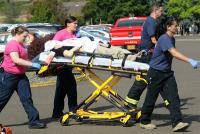-
Most guns recovered by Pittsburgh police not in possession of legal owners
Nearly 80 percent of perpetrators carrying a gun recovered by Pittsburgh Police were not the lawful owners, a strong indication that theft and trafficking are significant sources of firearms involved in crimes in southwest Pennsylvania, a new study finds. The finding suggests a timely opportunity for collaboration between public health and law enforcement officials better to understand and reduce violent crimes involving firearms.
-
-
Syrian asylum-seeker who blew himself up in Ansbach, Germany, was about to be deported
A 27-year old Syrian refugee whose asylum application had been denied, and who was about to be deported to Bulgaria, blew himself up Sunday evening outside a wine bar in the Bavarian town of Ansbach. Twelve people were injured in the explosion, three of them seriously. The past week was a particularly violent week in Germany, with a 21-year-old Syrian refugee knifing a woman to death in the city of Reutlingen on Sunday, and a mentally unstable 17-year old German teenager of Iranian descent, who was obsessed with mass shooting, killing nine people on Friday in a shopping mall in Munich, before turning his gun on himself.
-
-
U.K. reviews security measures for large outdoor events
Amber Rudd, the new British home secretary, told the House of Commons that she has ordered a full review of the security measures taken to protect large outdoor events such as festivals and other public gatherings. The review comes in the wake of the attack in Nice on revelers celebrating Bastille Day. Rudd said that additional security measures will be put in place, including what is known as the “national barrier asset” when police assess that there is a risk of vehicle attacks.
-
-
3D printing: a new threat to gun control and security policy?
The threat of self-manufactured firearms is not new, but a critical barrier is collapsing. Until recently, most people did not have the skills to make a weapon as capable as commercially available ones. However, recent developments in the field of additive manufacturing, also known as 3D printing, have made home manufacturing simpler than ever before. The prospect of more stringent gun safety legislation is also fueling interest in at-home production. The worst threats 3D printing poses to human life and safety are likely some distance in the future. However, the harder policymakers and others work to restrict access to handguns or unconventional weapons, the more attractive 3D printing becomes to those who want to do harm.
-
-
Shooter motivated by 1960s-era Black Nationalism

Gavin long, 29, who shot and killed three policemen in Baton Rouge before being fatally shot by the police, appears to have been motivated by 1960s-era Black Nationalism, which called on African Americans to take a strong, even violent, stance against mistreatment by authorities. Long left a long trail of on-line material, both postings and videos. In another video, referring to Native Americans, Long said, “When they were extincted [sic] by the same people that run this country, my question to you, just something you can think about: At what point should they have stood up?”
-
-
Reducing civilian firepower would boost police, community safety: Expert

A recent study examined data on the number of homicidal deaths of police in two groups of states with roughly equal number of police officers – the eight states with the lowest levels of gun ownership and the twenty-three states with the highest rate of gun ownership. The study found that, over the period from 1996 to 2010, the rate of police homicide in the high-gun prevalence states was three times as high as the rate of police homicide in the low-gun prevalence states. In addition to restricting the firepower a person can amass, a Stanford University expert advocates efforts to build trust between communities and law enforcement agencies as a way to enhance both police and citizen safety.
-
-
Allocation of police resources affects economic urban welfare, inequality
Decisions about how to allocate police resources in a community are likely to influence not only crime but also housing prices, overall economic welfare, and social inequality, according to a new study by economists. The researchers develop a model for examining the behavior of socioeconomic groups in response to two possible strategies: one in which police are concentrated in certain areas and another in which they are dispersed equally across the city. The researchers conclude that equal dispersal of police will lead to a city which is economically integrated, with housing prices comparable from one neighborhood to the next. Concentrating police in certain locations will lead to unequal neighborhoods but may produce greater overall wealth.
-
-
Quantifying the social cost of firearms: a new approach to gun control

Another week in America, another week of sadness and hand-wringing prompted by gun violence – but the current debate focuses on the most violent actors (terrorists or those whose background check may not check out) and the most lethal guns (military-style rifles) — not necessarily the deadliest guns or those creating the greatest risks to society. A new dialogue is desperately needed among policymakers and the public. And it could begin by shifting our focus away from the regulation of guns toward understanding (and mitigating) the social costs of firearm fatalities. A potential reframing of the issue might be to estimate the social cost of gun deaths, establish the burden borne by each weapon, and seek policies that reflect it in the market for firearms. Across many different areas of government, this kind of analysis is applied all the time when examining the benefits and costs of potential policies. There may be enough Republican and Democrat lawmakers open to the idea of market-based policies that don’t directly restrict gun access, progressively impose higher costs to more dangerous guns, and generate resources to improve the safety and security associated with guns in America.
-
-
Bahamas warns young men traveling to U.S. to “exercise extreme caution” around police
The government of the Bahamas late last week has issued a travel guidance to young Bahamian men travelling to the United States on holiday, warning them to “exercise extreme caution” when interacting with the U.S. police officers. “Do not be confrontational and cooperate” with the police, the Foreign Ministry’s travel guidance says.
-
-
Five officers killed by a sniper in Dallas (updated)
Five police officers were killed, and seven officers and two civilians injured, on Thursday by 25-year old Micha Xavier Johnson, who opened fire on the officers during a protest march in Dallas. During a 3-hour standoff with the police, Johnson said he was not associated with any group or organization, and that his only purpose was to kill White people – especially White police officers. It was the deadliest attack on law enforcement officers since the 9/11 terrorist attacks.
-
-
Can we predict who will become mass shooters?
The Orlando nightclub attack on 12 June was among the deadliest in American history, and it was the 133rd mass shooting to take place in the United States in 2016 alone. In the aftermath of the shooting, there has been a growing discussion about introducing new laws to make it harder for mad or bad people to get their hands on guns. But what else can we do to try to bring this under control? Working on ways to perhaps recognize people who might develop into mass killers – and the reasons they have for doing so – would obviously be an important step forward.
-
-
Applying public health models to gun violence

Research treats shootings like an epidemic — by applying public health models. Data indicate an individual’s odds of being a gunshot victim increase with exposure to gun violence. The work focuses not on mass shootings or isolated incidents of violence – rather, the researchers have worked to gather data on populations that face persistent threats of gun-related attacks and homicides, often connected to gang and drug activity.
-
-
Brazil lends $895 million to Rio de Janeiro for Olympics security
Brazil’s government has loaned 2.9 billion reais ($895 million) to the state of Rio de Janeiro to cover some of the security costs of the Olympic Games, which open on 5 August. The state of Rio de Janeiro last week declared a state of fiscal emergency. Government officials said the loan was meant to guarantee safety and security at the Olympic Games. As many as half a million foreign visitors are expected to arrive in Rio during the state’s worst financial crisis in decades.
-
-
Supreme Court: Domestic violence perpetrators can be banned from buying, owning guns

The supreme court has ruled that individuals convicted of a domestic violence “misdemeanor” can be prohibited from owning or purchasing a gun. Previous law stated that only those convicted of intentional abuse would be barred from owning weapons, but a “reckless” assault could be pardoned. In the United States, around five women a day are shot to death by current or former intimate partners. At least 52 percent of American women murdered with guns every year are killed by intimate partners or family members.
-
-
French beaches to be patrolled by armed police lifeguards
The vacation season in France is about the start, and the French authorities have decided to place armed police lifeguards – who will also wear bullet-proof vests — on the country’s busiest beaches amid fears that terrorists may target beachgoers and vacationing families. Islamist terrorists have recently attacked beach resorts in Tunisia and Ivory Coast.
-
More headlines
The long view
Why Was Pacific Northwest Home to So Many Serial Killers?
Ted Bundy, Gary Ridgway, George Russell, Israel Keyes, and Robert Lee Yates were serial killers who grew up in the Pacific Northwest in the shadow of smelters which spewed plumes of lead, arsenic, and cadmium into the air. As a young man, Charles Manson spent ten years at a nearby prison, where lead has seeped into the soil. The idea of a correlation between early exposure to lead and higher crime rates is not new. Fraser doesn’t explicitly support the lead-crime hypothesis, but in a nimble, haunting narrative, she argues that the connections between an unfettered pollution and violent crime warrant scrutiny.
